Old Market was one of the areas of Bristol that had been neglected, but over the last few years has been revamped and is now a more pleasant place to visit, with most of the buildings have been tidied up.
As you approached Old Market from Temple Way there is a huge modernist building in brown brick that you can't miss. This is the old Bristol Evening Post print hall and offices which were built in 1974. The print hall was demolished in 2011, and the remaining building remodelled. When it was built, many people thought it was too stark and ugly, but it did become a landmark building.
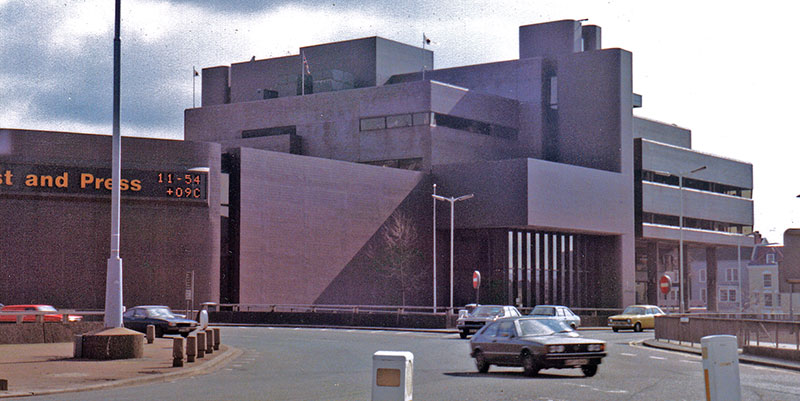
The Bristol Evening Post offices and print hall
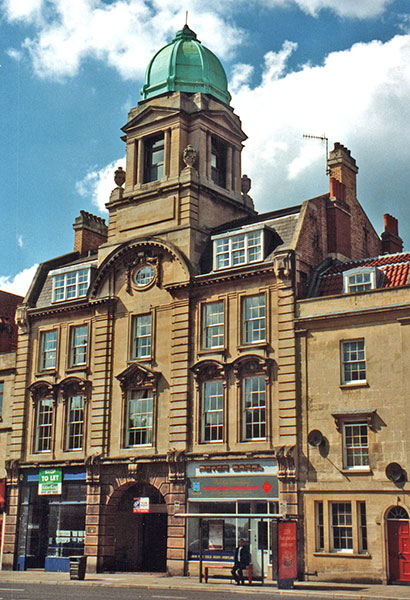
Old Methodist Central Hall
Originally built around 1923/24, the Methodist Central Hall was used for concerts, dancing and film shows. In the late 1980s the building was converted into flats. There was an older building here, the Old Market Wesleyan Methodist Chapel, which was built in 1815, enlarged in 1865, then demolished to make way for the present building.
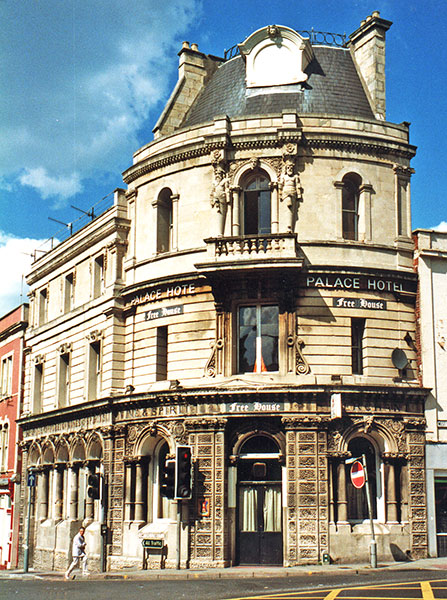
The Palace Hotel, otherwise known as The Gin Palace
This is my third attempt at writing the next paragraph, I hope I've got it right this time! The Palace Hotel built in 1869 by wine and spirits merchant, John Sharp, to take advantage of trade from the planned Great Western Railway GWR - sometimes known as God's Wonderful Railway) station and was originally planned to be called the Station or Railway Hotel. The station was never built, the GWR terminus was instead erected on the site of the old Bristol and Exeter station at Temple Meads. The Midland railway did build a station, Bristol St Philip's, nearby but attracted nowhere near the numbers of travellers that was expected from the GWR. That station was closed in 1953 and then demolished.
Its main claim to fame, however, is the floor of its bar. The road running to the left of the picture is on a slight incline, the floor of the bar follows the slope of the road! This makes getting drinks very easy, you simply stand up and you practically fall to the bar.
The building has changed hands a number of times. In 2000, Thomas Brooman, co-founder of World of Music, Arts and Dance (WOMAD) bought it, but closed it again in 2005. Other uses were planned for the building but in November 2008, the owners of the Bristol Bear Bar across the road reopened it. It closed again in March 2018. I have no idea whether it has opened again (October 2020).
While I was taking the photo of the Palace Hotel I found an almshouse that I hadn't realised existed. This has variously been known as Barstaple or Trinity or Holy Trinity Almshouse or Hospital in the centuries it has been existence. The buildings cover the area between Old Market Street, Midland Road and Jacob Street.
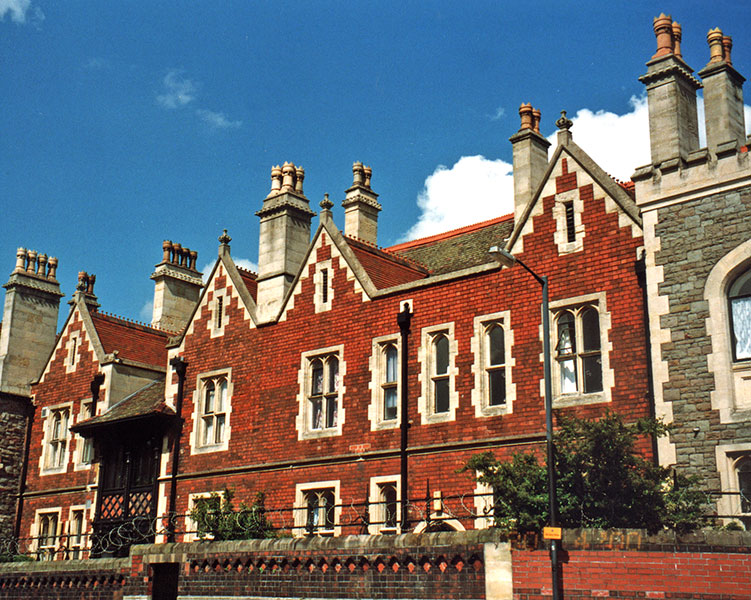
The Almshouse in Jacob Street
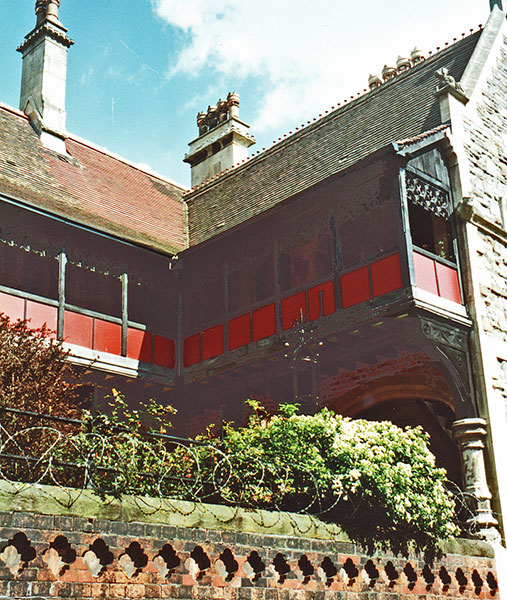
The front of the building is grand enough but back is magnificent
The original almshouse was built by Bristol merchant, John Barstaple around 1402. Barstaple was a civic leader being bailiff in 1379, Sherriff in 1389 and Mayor three times in 1395, 1401 and 1405. Barstable was granted a charter from King Richard II saying "John Barstaple, burgess of Bristol, to grant land in the suburb of Bristol to the mayor and commonalty of Bristol to build a hospital for poor persons." Barstaple died in 1411. The current buildings are varied in styles as the were extensively rebuilt between 1858 and 1883. The buildings were sold in 2010 and are now flats.
Maybe it's just me but most sources such as the Places of Worship Database and Bristol: A Worshipful Town and Famous City and others say the charter was granted by King Henry V who reigned from 1413 until his death in 1422. Perhaps this was a reaffirmation of the Richard II reference in the National Archives. Richard II reigned from 1377 until he was deposed in 1399. If the original building was built in 1402 then it might well have been granted by King Richard II or Henry IV who reigned from 1399 to 1413.
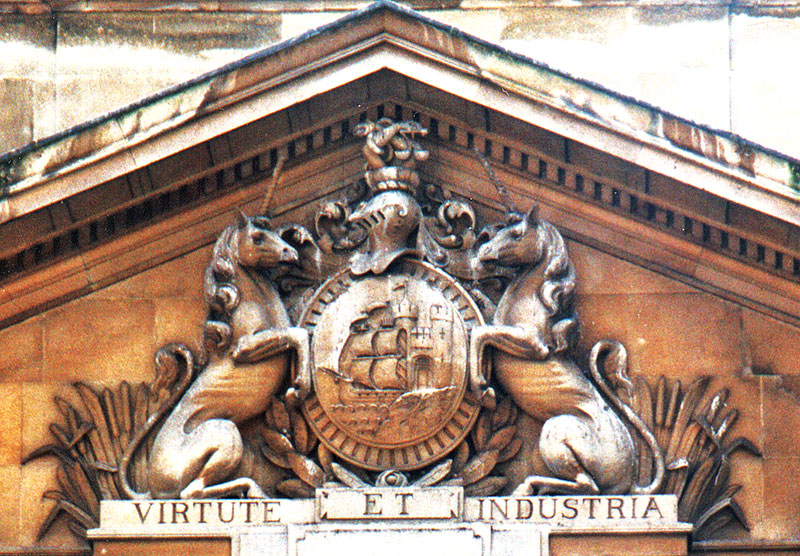
The City Arms
This is on the Old Market Drill Hall
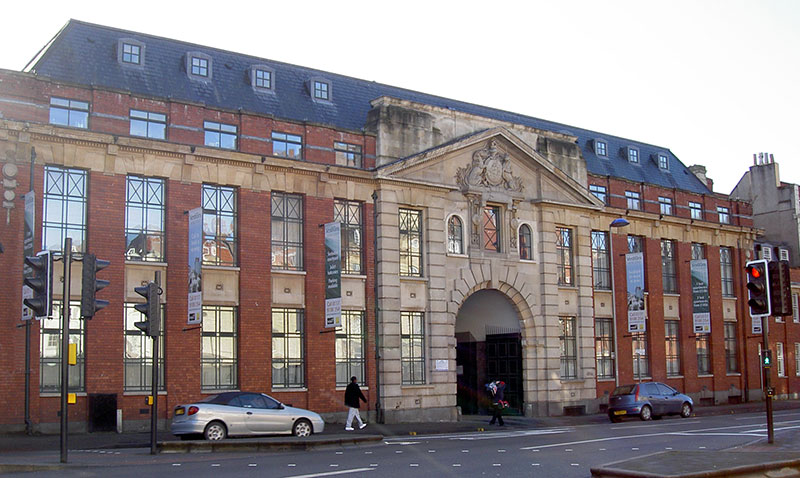
Old Market Drill Hall in 2012. Photo: Wikimedia
The Drill Hall was built on the site of an sugar warehouse and refinery as the home to 4th (City of Bristol) Battalion, The Gloucestershire Regiment in 1912. The building fell into disrepair after WWII and left derelict for many years. In 2005, it was used as a post office sorting office and converted into flats in 2007.
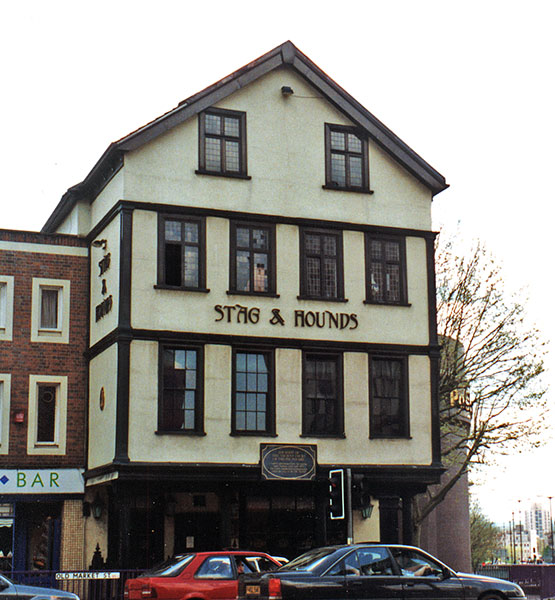
The Stag and Hounds stands near Old Market roundabout
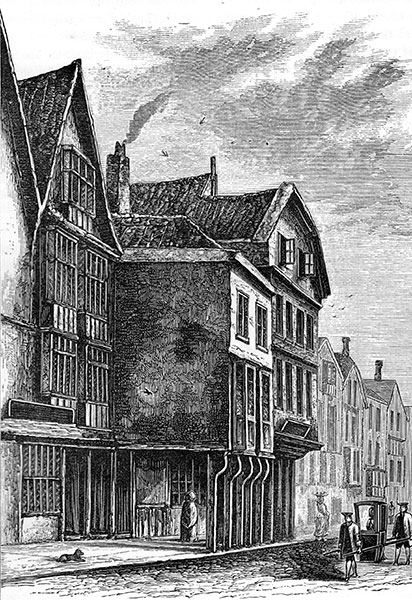
The Stag and Hounds in 1882, or possibly earlier. Image: Wikimedia
The Stag and Hounds was built in 1483, probably as a private house. It was at least partially reuilt in the early 18th century when it became a pub and partially rebuilt again the 1960s. The first recorded landlord of the pub was William Prowlin in 1792.
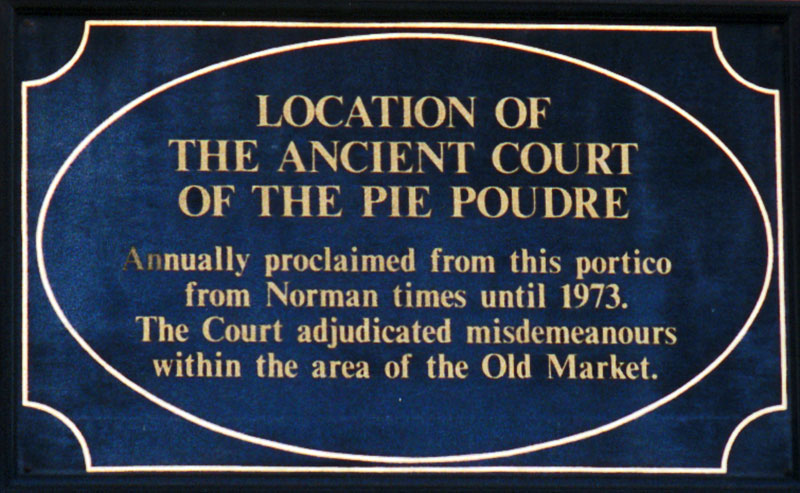
The Pie Poudre court sign on the Stag and Hounds, Old Market
Pie Poudre is from the French, pied poudres, or dusty feet. A vagabond is called in French pied poudreux. The Pie Poudre courts were an offshoot of the Tolzey or Sheriff's Court and the one at the Stag and Hounds is associated with the September fair in Old Market and was in existence some time before 1373. The court was originally held under an old oak tree before moving to the Stag and Hounds. The purpose of the Pie Poudre courts was to dispense speedy justice for those who were not permanent residents of the city, and would have been especially important to settle disputes on fair days. It was originally presided over by the Steward of the Tolzey Court until 1835 when the Recorder of Bristol took over. The opening of the court gradually became a cause for drunken festivities and the one in Old Market was suppressed in 1870, the last of the Pied Poudre courts. The annual proclamation was still read outside the Stag and Hounds until 1973.
I'd like to thank Mr Keith Hallett who first emailed me correcting a mistake I
made and who has since provided a great deal of information and ideas for these pages. He has also very kindly given me permission to use some of the stories and pictures that appear in these pages. Mr Hallett emigrated in 1955 and now lives in Grand Rapids, Michigan, USA. Mr Hallett has led an interesting life, having served on RMS Mauretania
- obviously not the first one, as that was scrapped in 1935.
I'd also like to thank Mr John Penny of Fishponds Historical Society who kindly provided some of the information about the railways.
Incidentally, the panneling in the restaurant of "The Mauretania" at the bottom of Park Street was taken from the original Mauretania when she was scrapped.
Mr Hallett was born in 1933 at 29 Midland Road, where his dad, Bob Hallett, owned the Bird Seed Specialist shop.
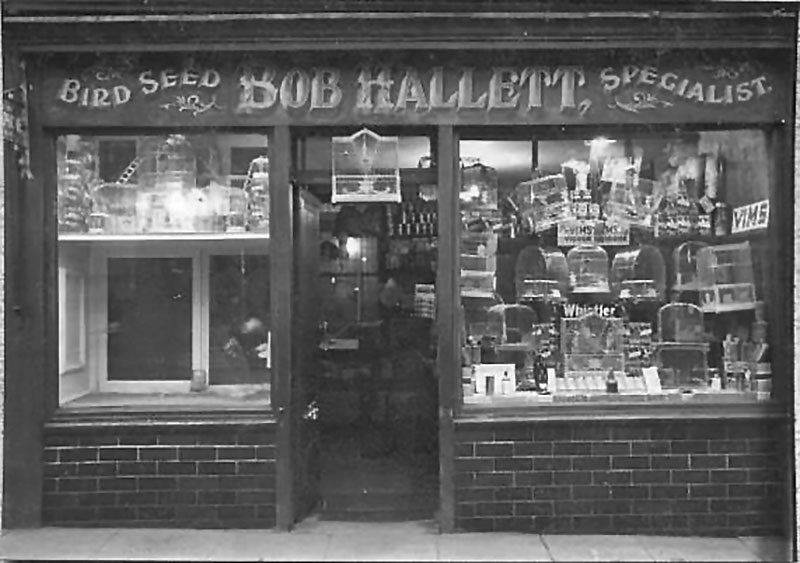
Mr Hallett's shop at 29 Midland Road, Old Market
Mr Hallett says
I can tell you there were some characters in those shops. Just a few doors up from my Dad's shop at No 29. there was "Staddons Cafe" or restaurant, owned by John Staddon. On weekends he did Staddons "Royal Punch" the Punch & Judy show on the sands at Weston-Super-Mare.
Opposite the Greyhound Pub was Charlie Heal's showgrounds (That must have generated a lot of
noise for the poor folks in the Almshouses next door). I correspond from time to time with a Bristol chap in Australia - Reg Kearn - he used to take the money on the dodgem's as a young lad.
During the war the Showgrounds and the pub's in the area were a magnet for American soldiers,
picking up girls. I heard of some knife fights when the black and white Yanks had a bit of aggro. In fact I believe they had a big fight in Old Market, and it took truck loads of American MP's "Snowdrops" to break it up.
Mr Hallett also remembers the railway station well and wrote this about it :-
St. Phillips LMS railway station did exist at the corner of Midland Road & Waterloo Road. As a child I remember all of the horse drawn wagons used by the LMS to and from the Goods Yard at the top of "The Batch".
The railway was one of the first to be built in the Bristol area and was originally known as the
Bristol & Gloucestershire railway when it opened in 1835 to bring coal into Bristol from the coalfields in South Gloucesterhire. It was operated by horses pulling the trucks in those days. In 1844 it became a proper passenger carrying railway but in 1846 was absorbed by the Midland Railway, later known as the London, Midland & Scottish Railway. The railways were nationlised in 1948 when it became part of the London Midland Region of British Railways. In the late 1860s,the vast and elaborate St Philip's Goods Yard was constructed. This was joined in 1871 by St Philip's station, built by the Midland Railway
adjacent to Midland Road (The Batch as it was known to locals). The line ran from St.Philips from 1870 to 1953 and after that from Temple Meads, via stations at Fishponds and Staple Hill to Mangotsfield Junction where one branch went to Bath and the other up to Gloucester. The line was closed in 1965 and a cycle track covers the whole of the route to Mangotsfield and on to Bath.
I believe my Auntie Win who lived at Filton used to come in to visit my Dad, via this railway.
Midland Road and Old Market St. in the 1930's /40's were really busy shopping centre's and St. Phillips Station was a convenient way for people living north of Bristol to come in to the City.
I also remember the night during WWII when the Luftwaffe dropped incendiary bombs that landed on the LMS stables, they had a terrible job trying to get the horses out to safety, but I believe many were lost. The actual station closed in 1953, although the goods yard carried on to 1967. It is now covered with industrial units, as is much of the area.
If you are interested in the history of the railways in Britain then probably the best site I've found is
Mike's Railway History. The site went offline in 2014 but Rob Dickinson very thoughtfully saved all the pages.
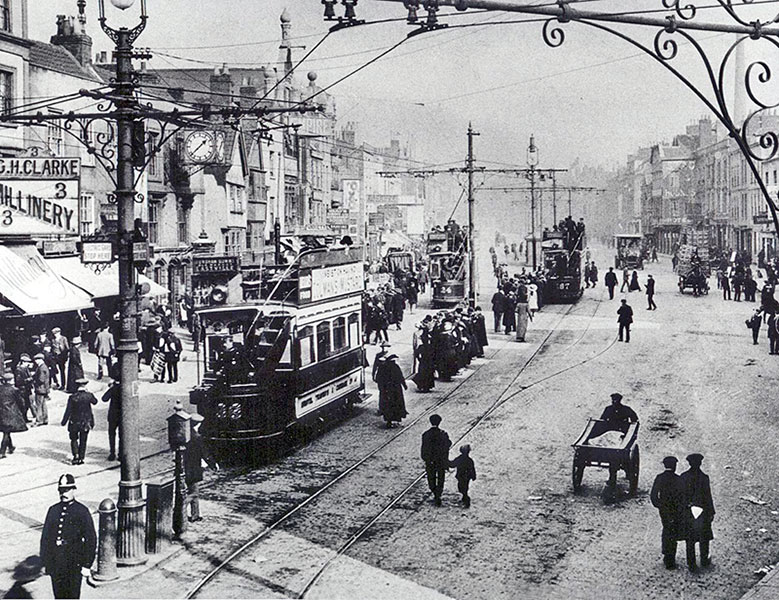
Old Market circa 1912
The image is of Old Market as I remember it in the 1930's trams and all. The buildings looked the
same. Look how busy it was.
My Dad always displayed a poster for the latest attractions to the "Empire Theatre" on
the corner of Old Market and Carey's Lane. In exchange he received two complimentary seats quite frequently. We would go together and absolutely loved it when D'Oyly Carte came to the Empire for a fortnight and usually staged about four Gilbert & Sullivan operetta's during the run.
Another artiste was "Bristol's very own Randolph Sutton" entertainer / vocalist. I
believe he was born at Clifton, and later lived at Barton Hill. I saw him on stage several times. He was very popular in the 1920's thru 1950's. I have heard that he could keep the Theatre Royal packed for a full house over 16 weeks, when he played there.
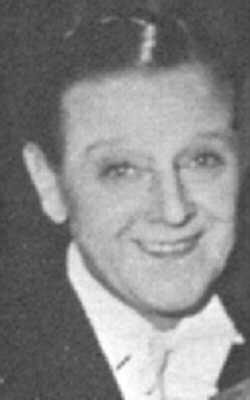
Randolph Sutton (1888 - 1969)
Randolph Sutton was born on July 24, 1888 and lived at 29 Anglesea Place, Clifton, Bristol. He became a star of British music hall making his first stage appearance in 1910. Year later, he appeared briefly in the long running soap opera Coronation Street in 1966. He died on February 28, 1969 in Brixton, London.
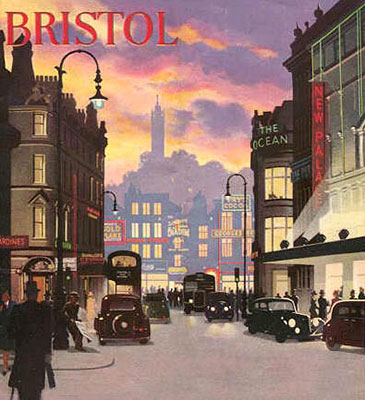
1930's Bristol brochure illustration from Keith Hallett
The poster which is instantly recognizable as being a view from Baldwin Street towards the city center with Cabot Tower behind is a bit fanciful.
This is what Google Maps Streetview shows it as in July 2019...
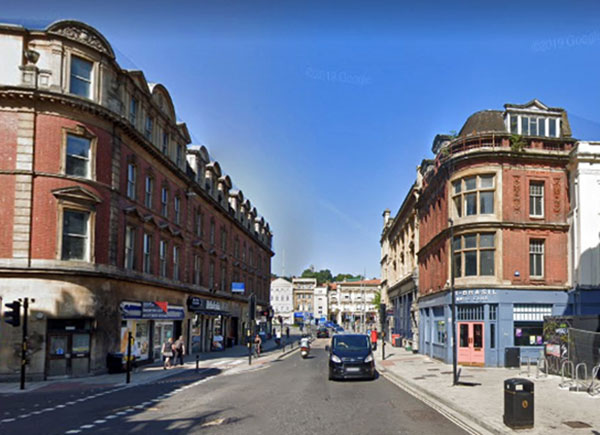
City Center from Baldwin Street, Google Maps Streetview, 2019
The theater at the right of the poster a little bit further back along Baldwin Street. Originally the People's Palace (1891), then the New Palace (1928), the Gaumont Cinema (1952), Busby Nightclub (1981), Ritzy Nightclub, Creation Nightclub (2003), Sports Cafe (2006), and finally turned into student flats (2019).
Once again, I'd like to give my appreciation to Mr Hallet for providing the idea, text and illustrations for this page and Mr John Penny of Fishponds Historical Society who kindly provided some of the information about the railways.
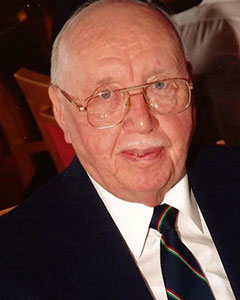 I was informed by his daughter Irene, that Keith Hallett passed away on October 10, 2020.
I was informed by his daughter Irene, that Keith Hallett passed away on October 10, 2020.
I never met him but we've been emailing each other for 20 years. He very kindly shared his experiences of growing up in Old Market, Bristol and living in the city during WWII and the bombings before being evacuated to Sherfield.
Later we'd share stories and jokes about Bristol and all sorts of other things. He really did have a fine sense of humour and I'll miss his emails.
Keith's Obituary
Keith remembers his time on the Ocean Monarch
Keith's YouTube Channel - There are not many people around who have cine film from their family dating from the 1930s.
Sources
13 Things You Didn’t Know About Old Market
A Look at Old Market Through more than a Century of Change - Some very nice historic photos of the area
An Atlas of Post-Reformation Places of Worship Within the Central Area of the City of Bristol
Bristol Charities: History of Almshouses
Bristol's Courts of Law
Bristol's Lost Pubs
Central Hall Bristol
Gaumont, Bristol
Half of Evening Post building to be demolished
Historic England: Holy Trinity Almshouses and Attached Walls and Railings To Jacob Street
Old Market Character Appraisal
Old Market Quarter
The Churches of Britain and Ireland
The Drill Hall Project
The People's Palace Theatre
Wikimedia
This page created May 5, 2000, last modified October 25, 2020















 I was informed by his daughter Irene, that Keith Hallett passed away on October 10, 2020.
I was informed by his daughter Irene, that Keith Hallett passed away on October 10, 2020.